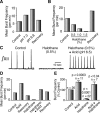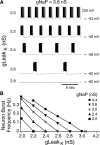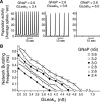TASK channels contribute to the K+-dominated leak current regulating respiratory rhythm generation in vitro
- PMID: 20335463
- PMCID: PMC2950010
- DOI: 10.1523/JNEUROSCI.4017-09.2010
TASK channels contribute to the K+-dominated leak current regulating respiratory rhythm generation in vitro
Abstract
Leak channels regulate neuronal activity and excitability. Determining which leak channels exist in neurons and how they control electrophysiological behavior is fundamental. Here we investigated TASK channels, members of the two-pore domain K(+) channel family, as a component of the K(+)-dominated leak conductance that controls and modulates rhythm generation at cellular and network levels in the mammalian pre-Bötzinger complex (pre-BötC), an excitatory network of neurons in the medulla critically involved in respiratory rhythmogenesis. By voltage-clamp analyses of pre-BötC neuronal current-voltage (I-V) relations in neonatal rat medullary slices in vitro, we demonstrated that pre-BötC inspiratory neurons have a weakly outward-rectifying total leak conductance with reversal potential that was depolarized by approximately 4 mV from the K(+) equilibrium potential, indicating that background K(+) channels are dominant contributors to leak. This K(+) channel component had I-V relations described by constant field theory, and the conductance was reduced by acid and was augmented by the volatile anesthetic halothane, which are all hallmarks of TASK. We established by single-cell RT-PCR that pre-BötC inspiratory neurons express TASK-1 and in some cases also TASK-3 mRNA. Furthermore, acid depolarized and augmented bursting frequency of pre-BötC inspiratory neurons with intrinsic bursting properties. Microinfusion of acidified solutions into the rhythmically active pre-BötC network increased network bursting frequency, halothane decreased bursting frequency, and acid reversed the depressant effects of halothane, consistent with modulation of network activity by TASK channels. We conclude that TASK-like channels play a major functional role in chemosensory modulation of respiratory rhythm generation in the pre-Bötzinger complex in vitro.
Figures









Similar articles
-
Persistent Na+ and K+-dominated leak currents contribute to respiratory rhythm generation in the pre-Bötzinger complex in vitro.J Neurosci. 2008 Feb 13;28(7):1773-85. doi: 10.1523/JNEUROSCI.3916-07.2008. J Neurosci. 2008. PMID: 18272697 Free PMC article.
-
Persistent sodium current, membrane properties and bursting behavior of pre-bötzinger complex inspiratory neurons in vitro.J Neurophysiol. 2002 Nov;88(5):2242-50. doi: 10.1152/jn.00081.2002. J Neurophysiol. 2002. PMID: 12424266
-
Respiratory rhythm generation and synaptic inhibition of expiratory neurons in pre-Bötzinger complex: differential roles of glycinergic and GABAergic neural transmission.J Neurophysiol. 1997 Apr;77(4):1853-60. doi: 10.1152/jn.1997.77.4.1853. J Neurophysiol. 1997. PMID: 9114241
-
Spatial organization and state-dependent mechanisms for respiratory rhythm and pattern generation.Prog Brain Res. 2007;165:201-20. doi: 10.1016/S0079-6123(06)65013-9. Prog Brain Res. 2007. PMID: 17925248 Free PMC article. Review.
-
Sodium leak channels in neuronal excitability and rhythmic behaviors.Neuron. 2011 Dec 22;72(6):899-911. doi: 10.1016/j.neuron.2011.12.007. Neuron. 2011. PMID: 22196327 Free PMC article. Review.
Cited by
-
Advances in the Understanding of Two-Pore Domain TASK Potassium Channels and Their Potential as Therapeutic Targets.Molecules. 2022 Nov 28;27(23):8296. doi: 10.3390/molecules27238296. Molecules. 2022. PMID: 36500386 Free PMC article. Review.
-
TASK1 and TASK3 Are Coexpressed With ASIC1 in the Ventrolateral Medulla and Contribute to Central Chemoreception in Rats.Front Cell Neurosci. 2018 Aug 29;12:285. doi: 10.3389/fncel.2018.00285. eCollection 2018. Front Cell Neurosci. 2018. PMID: 30210304 Free PMC article.
-
Structural-functional properties of identified excitatory and inhibitory interneurons within pre-Botzinger complex respiratory microcircuits.J Neurosci. 2013 Feb 13;33(7):2994-3009. doi: 10.1523/JNEUROSCI.4427-12.2013. J Neurosci. 2013. PMID: 23407957 Free PMC article.
-
Respiratory rhythm generation in vivo.Physiology (Bethesda). 2014 Jan;29(1):58-71. doi: 10.1152/physiol.00035.2013. Physiology (Bethesda). 2014. PMID: 24382872 Free PMC article. Review.
-
The respiratory control mechanisms in the brainstem and spinal cord: integrative views of the neuroanatomy and neurophysiology.J Physiol Sci. 2017 Jan;67(1):45-62. doi: 10.1007/s12576-016-0475-y. Epub 2016 Aug 17. J Physiol Sci. 2017. PMID: 27535569 Free PMC article. Review.
References
-
- Bayliss DA, Siros JE, Talley EM. The TASK family: two-pore-domain background K+ channels. Mol Interven. 2003;3:205–219. - PubMed
-
- Burdakov D, Jensen LT, Alexopoulos H, Williams RH, Fearon IM, O'Kelly I, Gerasimenko O, Fugger L, Verkhratsky A. Tandem-pore K+ channels mediate inhibition of orexin neurons by glucose. Neuron. 2006;50:711–722. - PubMed
-
- Butera RJ, Jr, Rinzel J, Smith JC. Models of respiratory rhythm generation in the pre-Botzinger complex. I. Bursting pacemaker neurons. J Neurophysiol. 1999a;82:382–397. - PubMed
-
- Butera RJ, Jr, Rinzel J, Smith JC. Models of respiratory rhythm generation in the pre-Botzinger complex. II. Populations of coupled pacemaker neurons. J Neurophysiol. 1999b;82:398–415. - PubMed
Publication types
MeSH terms
Substances
Grants and funding
LinkOut - more resources
Full Text Sources
Other Literature Sources
Medical
